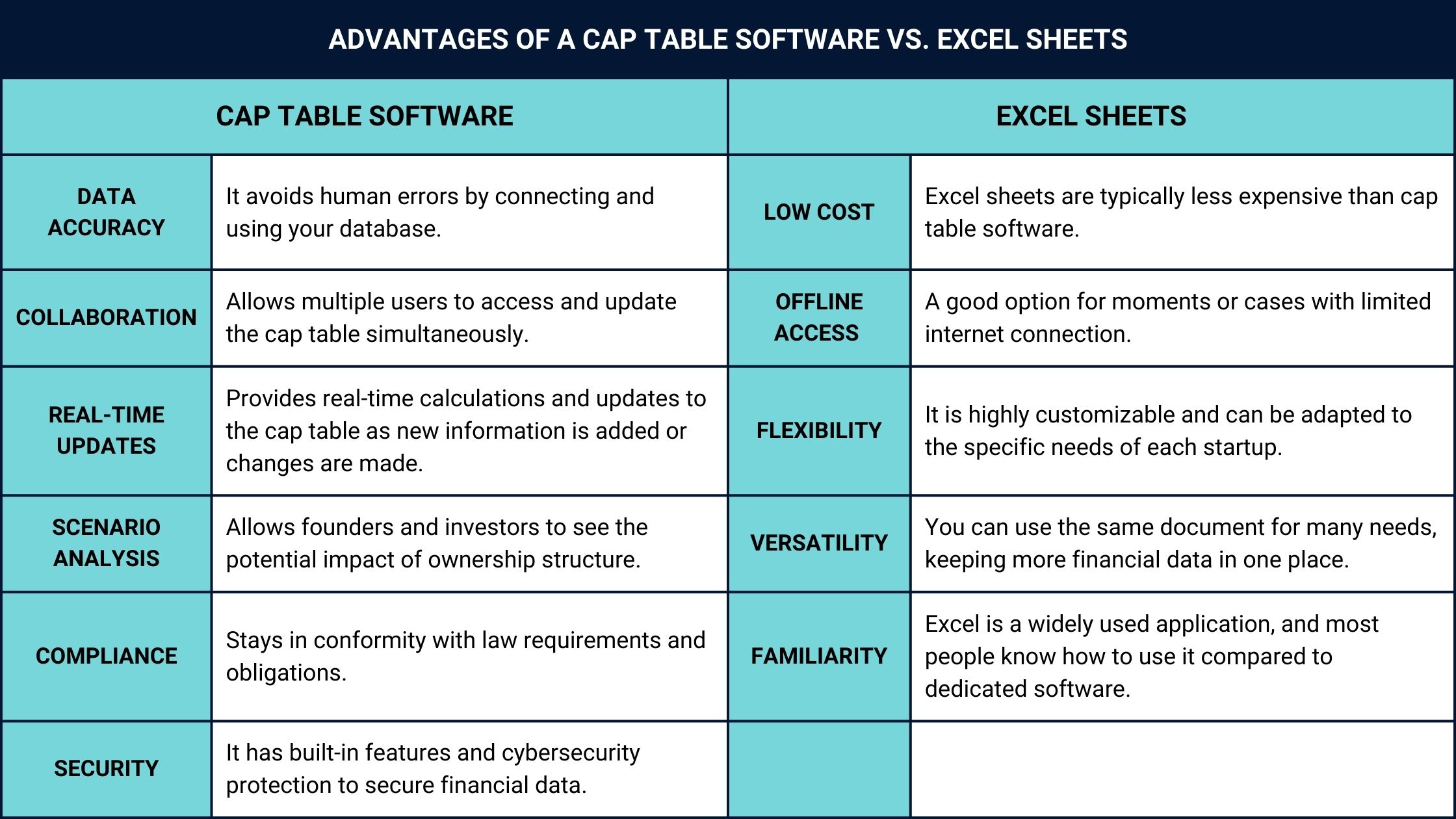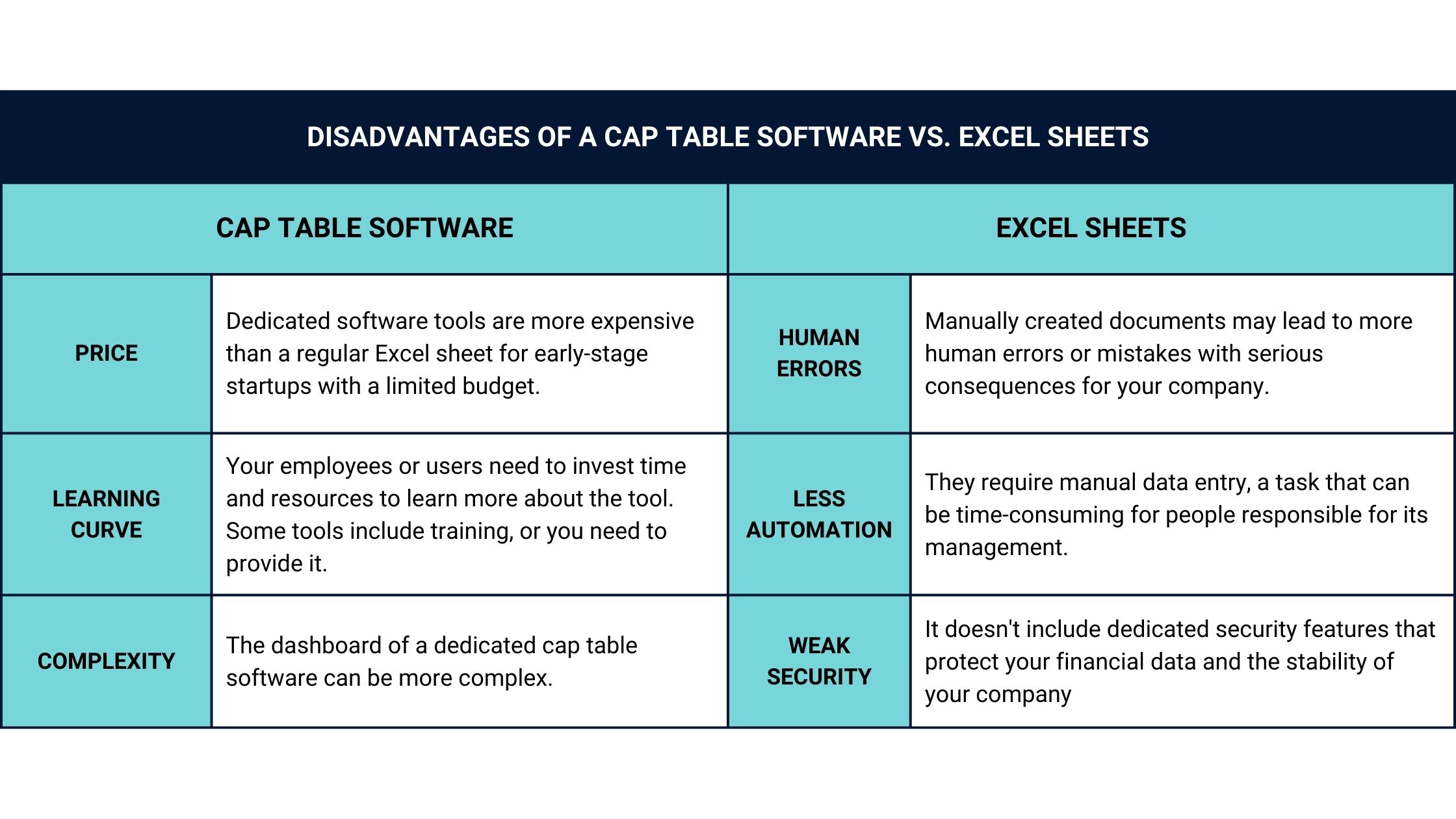SeedBlink Blog
startups And Financing
Managing Startup Equity: What is a Cap Table and Why You Need One
Discover what a cap table is and how to create and manage one effectively. Learn the common mistakes to avoid and the benefits of using specialized software.
When starting a new business, one of the most important things to consider is represented by the company's shares. A cap table is a key document that outlines the ownership structure of a company and its equity capitalization.
Today, we’ll explore a cap table, why it is important for startups, and how to create and manage it effectively. We will also discuss the common mistakes to avoid when setting up and maintaining a cap table and the benefits of using specialized software to manage this critical document. By the end of this article, you will have a clear understanding of the cap table and its role in the success of your startup.
What is a cap table?
A cap table, short for capitalization table, is a document that outlines the ownership structure of a company. It provides a breakdown of the total number of outstanding shares in the company, who owns them, and how much each owner.
The cap table typically includes information about equity ownership, such as stock options, warrants, convertible notes, and other types of securities. Cap tables are typically used by startups and early-stage companies, as well as their investors and advisors.
It’s important to track how equity changes as the company grows and raises additional funding. It is also an essential tool for understanding the company's ownership structure, which can help with decision-making related to fundraising, mergers and acquisitions, and equity distribution.
Why do startups need a cap table?
A study by Shareworks found that nearly 50% of private company employees need help understanding their equity compensation, highlighting the importance of clear communication and education around cap tables.
Cap tables are essential for early-stage companies seeking investments, as they provide transparency and improve the negotiation between startups and investors. According to a survey by Harvard Business Review, 80% of investors believe that the cap table is one of the most important documents to review before investing in a startup.
So, let’s take a deeper look at the cap table's usefulness during the fundraising journey of a startup!
1. For ownership tracking
A cap table provides a clear and concise picture of who owns what percentage of a company. As your startup grows, attracting new financing rounds and new investors, the cap table helps you track the number of shares for each shareholder and avoid conflicts or misunderstandings.
2. For valuation and fundraising
A cap table can help startups determine their valuation and calculate the dilution of existing shareholders when raising additional funds. When negotiating the terms and conditions for a new investment round with a potential investor, a cap table helps you offer a clear perspective to investors and existing shareholders, allowing them to make more informed decisions.
3. For mergers and acquisitions
When a company is being acquired or merged with another company, a cap table is essential to determine the ownership distribution and how much each shareholder will receive.
4. For equity compensation
Startups often use equity compensation to incentivize employees, contractors, and advisors. A cap table helps the company keep track of the issuance and vesting of employee stock options, restricted stock, or other equity awards. All the mentioned stakeholders could use the same cap table to keep track of their options and participation in the company equity.
The benefits of a cap table
A cap table is a crucial tool for founders and their startups.
Firstly, a cap table provides a clear picture of the company's ownership structure, enabling founders to understand the dilution potential of future funding rounds and make informed decisions about fundraising.
Secondly, a cap table helps founders manage equity compensation for employees, advisors, and other stakeholders. Founders can use the cap table to track the vesting of equity grants, calculate the value of equity compensation packages, and ensure that the company stays within its equity pool limits.
Other main benefits of a cap table for a startup are:
It is mandatory before performing any valuation.
A cap table allows founders and investors to calculate the company's total equity value and the value of each shareholder's stake. This information is crucial when raising funds, negotiating terms with investors, and planning for the company's future.
It allows better decision-making.
A cap table gives founders and investors the information they need to make informed decisions about the company's future. By understanding the ownership structure, valuation, and potential dilution of existing shareholders, you can make strategic decisions about fundraising, mergers and acquisitions, and equity compensation.
Cap Table Software vs. Excel Sheets
There are two main options for cap table management: Cap Table Software and Excel Sheets.
While both tools can be used to create and manage a cap table, there are distinct differences. According to recent reports, over 60% of startup founders worldwide and more than 70% of European startups use Excel spreadsheets to manage their cap tables, despite the risks of errors and lack of security.
Let’s explore the advantages and disadvantages of each option, discover the pros and cons of cap table software versus Excel sheets, and make an informed decision about which option to choose.
Advantages of a cap table software

A cap table software offers many advantages over Excel sheets, such as automation, collaboration, and compliance; it may be though more expensive and complex.
On the other hand, an Excel cap table template offers flexibility and familiarity but has limitations regarding security, collaboration, and automation.
Disadvantages of a cap table software

How to use a cap table
Cap tables enable founders and investors to make informed decisions about the company's future and provide transparency and accountability to all stakeholders.
5 common errors in setting up a cap table
The cap table represents the company's ownership structure and is a critical tool for founders, investors, and other stakeholders. Errors in the cap table can lead to a misrepresentation of ownership, potentially causing disputes, disagreements, or legal issues.
A few best practices can help you avoid errors in a cap table and ensure you have an up-to-date instrument to manage your company’s equity structure, valuation, and compliance obligations. Here are some of the most common mistakes founders face and how to avoid them:
Inaccurate shareholder information.
One of the most common errors in setting up and maintaining a cap table is inaccurate or incomplete shareholder information.
Gather accurate and complete shareholder information, including each shareholder's name, contact information, and security type. This will help ensure an accurate and up-to-date cap table.
Incorrect share quantity.
Another common error is incorrect share quantity. It is important to have an accurate number of shares or units of each security type issued to each shareholder and input the correct data into the cap table.
Calculate the number of shares or units of each security type issued to each shareholder and double-check the accuracy of the data introduced into the cap table.
Miscalculation of dilution.
Dilution is an important factor when setting up a cap table. It is necessary to understand how new equity issuances, conversions, or anti-dilution provisions affect existing shares' ownership structure and value.
Additionally, you need to calculate dilution correctly to avoid incorrect valuations and unfair equity distribution. Lastly, create a model with different scenarios and consider the impact on existing shareholders before issuing new equity.
Omission of convertible securities.
The company’s securities, such as convertible debt or notes, can be complex and often overlooked when setting up a cap table.
Include all securities issued, such as convertible debt or other types of securities that may convert into equity, and consider their potential conversion into equity when setting up the cap table.
Lack of compliance with legal and regulatory requirements.
Cap tables are critical compliance documents required to comply with the country's law, and the lack of these requirements can result in legal and regulatory issues.
5 tips & tricks to manage a cap table
Keep your cap table updated.
One of the most important things to do when managing a cap table is to keep it updated, as it can bring you multiple benefits in future financing rounds. Update your cap table regularly to reflect changes in the ownership structure, new funding rounds, or other events that affect the company's valuation or dilution.
Model different scenarios.
Cap tables help you create and model different scenarios to understand the potential impact of ownership structure and dilution of existing shareholders. The information within cap tables helps founders during fundraising processes, mergers and acquisitions, and equity management.
Implement a dedicated tool for better decisions.
With dedicated equity management software implemented in your company, you can manage equity faster and simpler than an Excel sheet. These tools provide automation, collaboration, and compliance features to help you maintain an accurate and up-to-date cap table.
Share it with key stakeholders.
Keep everyone on the same page by clearly understanding the company’s ownership percentages. Sharing your cap table with key stakeholders, such as investors, board members, and employees, promotes transparency and accountability.
Keep it confidential.
Cap tables contain sensitive financial data, and it is important to keep them confidential to protect this information and comply with legal and regulatory obligations. Use password protection, encryption, and other security features to secure the cap table.
To summarise, a cap table is an important tool for founders and their startups. It provides a clear picture of the company’s ownership structure, enables informed decision-making about equity compensation, and helps promote transparency within the company.
Thank you for reading this guide! Now, it’s time to open your cap table and manage it right!
Join our newsletter
Your go-to source for European startup news, equity trends, VC insights, and investment opportunities.
